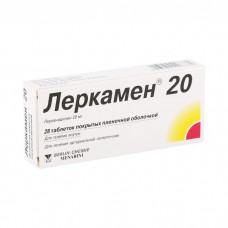Expiration date: 01/2025
Release form and composition:
Tablets coated with a film of reddish-pink color, round, biconvex, with a risk on one side.
1 tablet:
lercanidipine 20 mg
Excipients: lactose monohydrate, microcrystalline cellulose, sodium carboxycrystalline type a, povidone K30, magnesium stearate.
Shell composition: hypromellose (hydroxypropylmethylcellulose), talc, titanium dioxide, macrogol 6000, iron oxide (III).
7 PCs. - blisters (1) - cardboard packs.
7 PCs. - blisters (5) - packs of cardboard.
10 PCs. - blisters (5) - packs of cardboard.
10 PCs. - blisters (10) - packs of cardboard.
14 PCs. - blisters (1) - cardboard packs.
14 PCs. - blisters (2) - packs of cardboard.
14 PCs. - blisters (3) - packs of cardboard.
14 PCs. - blisters (4) - packs of cardboard.
14 PCs. - blisters (7) - packs of cardboard.
Pharmacological action:
Blocker of slow calcium channels, a derivative of the dihydropyridine series. It inhibits transmembrane calcium flow to cardiomyocytes and smooth muscle cells. The mechanism of the hypotensive effect is due to a direct relaxing effect on vascular smooth muscles, as a result of which the OPSS is reduced. It has a prolonged antihypertensive effect. Due to its high selectivity, there is no negative inotropic effect.
The duration of the therapeutic effect is 24 hours.
Pharmacokinetics:
Suction
After oral administration in a dose of 10-20 mg is completely absorbed. Cmax in blood plasma is detected after 1.5-3 hours and is 3.3 ng / ml and 7.66 ng / ml, respectively.
Distribution
Distribution from blood plasma to tissues and organs is rapid. Binding to plasma proteins exceeds 98%.
There is no accumulation during repeated intake.
Metabolism
Undergoes metabolism.
Breeding
The average T1 / 2 is 8-10 hours.
Indications:
- mild to moderate essential arterial hypertension.
Dosage mode:
The drug is taken orally.
Assign 10 mg 1 time/day at least 15 minutes before meals, preferably in the morning. Depending on the achieved therapeutic effect, the dose may be increased to 20 mg.
The therapeutic dose is selected gradually, if necessary, increasing the dose to 20 mg is carried out 2 weeks after the start of taking the drug.
The tablet should preferably be swallowed whole with a sufficient amount of water.
Side effect:
From the cardiovascular system: rarely observed effects associated with vasodilator action-peripheral edema, feeling of blood flushing to the face, palpitations, tachycardia, chest pain, decreased blood PRESSURE, angina, myocardial infarction, asthenia, fatigue, headache, dizziness.
From the digestive system: very rarely - dyspepsia, nausea, vomiting, epigastric pain, diarrhea, reversible increase in liver enzymes, gum hyperplasia.
Other: very rare - polyuria, skin rash, drowsiness, myalgia.
The drug is characterized by good tolerance.
Contraindications:
- chronic heart failure in the decompensation stage
- unstable angina
- aortic stenosis
- within 1 month after a myocardial infarction
- severe liver function disorders
- impaired renal function (CC less than 10 ml / min)
- lactose intolerance
- galactosemia
- glucose/galactose malabsorption syndrome
- pregnancy
- lactation period (breastfeeding)
- women of childbearing age who do not use reliable contraception
- children and adolescents under 18 years of age (efficacy and safety have not been established)
- hypersensitivity to the components of the drug
- hypersensitivity to other dihydropyridine derivatives.
With caution, it should be used for renal and/or hepatic insufficiency of mild to moderate degree, in elderly patients, with SSSI (without a pacemaker), CHD, left ventricular dysfunction.
Pregnancy and lactation:
The drug is contraindicated for use during pregnancy and lactation (breastfeeding).
Special instruction:
In patients with renal or hepatic insufficiency of mild or moderate severity, as a rule, dose adjustment is not required, you should carefully increase the dose of the drug to 20 mg/day.
In elderly patients, dose adjustment is not required.
Use in Pediatrics
Data on the use of the drug in patients younger than 18 years is not available.
Influence on the ability to drive vehicles and manage mechanisms
Since vertigo, asthenia, fatigue and, in rare cases, drowsiness may occur during Lerkamen therapy, patients should drive with extreme caution and engage in other potentially dangerous activities that require a high rate of psychomotor reactions.
Overdose:
There is no information about an overdose.
Symptoms: it is assumed that the development of symptoms is the same as with an overdose of other dihydropyridines-peripheral vasodilation with hypotension and reflex tachycardia, an increase in the frequency and duration of angina attacks, myocardial infarction.
Treatment: symptomatic therapy.
Drug interactions:
During the combination therapy of Sarkamen well compatible with beta-adrenoblokatorami, dioretikami, ACE inhibitors.
With caution, it should be prescribed with SURZA4 inhibitors (including ketoconazole, intraconazole, erythromycin). When Lerkamen is prescribed together with CYP3A4 inducers (including antidepressants, rifampicin), the hypotensive effect of the drug may be reduced.
May increase the hypotensive action Leromena by drinking grapefruit juice.
Ethanol can potentiate the effect of the drug.
Storage conditions and terms:
List B. the Drug should be stored out of the reach of children, at a temperature no higher than 30°C. Shelf life-3 years.



